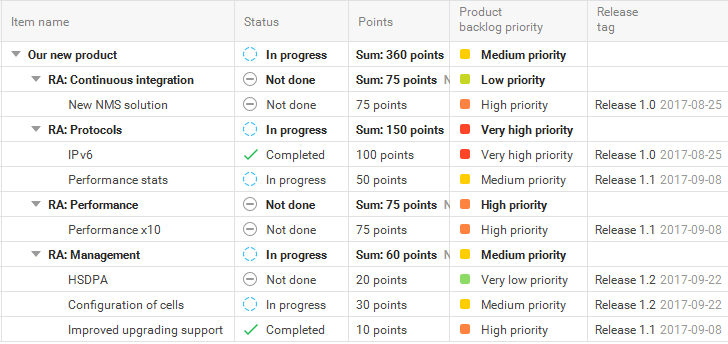
Product Backlog
Product backlog is the prioritized list of features used for product development.
Product backlog goals:
Creation of user stories.
Flexibility to adapt to new needs and realities.
Collaborated platform for product release.

Product backlog items:
Features
These new features emerge from the sales team, operation employees,
customers, intermediaries, customer service team and so on.
Prioritizing new features have hurdles such as keeping existing customers
happy, creating the lead for future sales, and striving
hard to attain company vision.
The onus is on the product manager to resolve any
issues pertaining to prioritization.
Technical debt
Reducing maintenance costs.
Making infrastructure change in case of manufacturing concerns and
architectural changes in case of information technology companies.
These are called technical debt due to its impact on the long term goals.
Bugs/ customer problems
Research
Product backlog team
Team member: works on the user stories created by the agile team.
Product owner:inspecting progression of new features and refining.
Project manager: Product development and the progres.
Stakeholders: working on the schedule and looking for the final product.
Initiatives
These are a set of epic is aiming towards attaining the goal specified. It works based
on cross functional teams and sometimes on matrix structures.
Example; Develop a new smart phone with foldable design, AI tools, and 5G technology.
Epics
The method of dividing the large work into small tasks.:
Example : collection of stories is called epics.
Smartphone foldable design.
Smartphones built with the feature of AI based marketing tools.
Smartphone with 5G feature.
Stories
These are called ‘user stories'. It is the requirement plan from the customer's perspective.
Examples:
Google meet need attendance feature built in rather than as add on.
Smartphones built with the feature of AI based marketing tools.
Foldable helmets for ladies.
Additive manufacturing for casting.
Two Rs of the product backlog
Road map development
Product backlog refinement
The Sprint team prepares the detailed estimate description.
Sprint team assures the ‘ready’ position
Ready position can be achieved before the sprint meeting or it may be just in time.
Refinement activities begin before the sprint meeting and continue later.
Refinement can be done by the product owner or development team.
Advantages of product backlogs
It guides the team towards attaining the goal.
Unlike the waterfall model agile team can begin working on ideas rather
than product backlog.
Team can remove product backlog items at any time of the process.
It reduces the time and avoids unnecessary discussion on the product.
Disadvantages of product backlog
Many time product backlog is not enough. Customer interactions provides more information.
There is no guarantee of product delivery.
Product backlog can stop the process at any stage.
Product Backlog development
|
User stories
|
Story points
|
Priority
|
|
High priority
|
The smartphone is having 5G feature so that i
can browse faster
|
4
|
1
|
|
The smartphone is in the regional languages
|
3
|
2
|
|
The smart phone can be folded
|
3
|
3
|
|
Low priority
|
The smartphone is having CDP for AI tools
|
4
|
4
|
Product backlog prioritization
This is the responsibility of the product owner.
High prioritization items have the options for refinement and have a
high value to the organization.
Middle prioritization items will become candidates for prioritization.
Low prioritization items can be ignored till it archives the candidate of middle prioritization.
Product backlog techniques
DIVE
Dependencies
Insure against risk.
Value
Estimated effort.
2. DEEP
Detailed approporities
Estimated
Emergent
Prioritized
3. INVEST
Independent
Negotiable
Valuable
Estimable
Testable
Grooming
Three principal activities of the product backlog are called grooming.
Creating and refining product backlogs.
Estimating product backlogs
Prioritizing product backlogs.
Grooming is the responsibility of the product owner.
Analytic product backlog items
Backlog item | Description |
Hypothesis | A good user story |
Data story | The data to be collected |
Change | The data change requested by the end user |
Technical improvement | Technology, machinery improvement |
Knowledge acquisition | Data discovery and prototype development |
References
VII, P. (2016). Agile Product Management: Product Backlog:
21 Tips To Capture and Manage Requirements with Scrum. (n.p.):
CreateSpace Independent Publishing Platform.
Rubin, K. S. (2012). Essential Scrum:
A Practical Guide to the Most Popular Agile Process. United Kingdom: Addison-Wesley.
Alt-Simmons, R. (2015).
Agile by Design: An Implementation Guide to Analytic Lifecycle Management.
United Kingdom: Wiley.
Sutherland, J., Coplien, J. O. (2019).
A Scrum Book: The Spirit of the Game. (n.p.): Pragmatic Bookshelf.
Single Reference Guide for Scrum Certification:
Professional Scrum Master I (PSM I) and Professional Scrum Product Owner I (PSPO I)
Certification. (2020). (n.p.): Vishal Malhotra.
Mir, R. C. (2020).
Iterative Business Model Canvas Development - From Vision to Product Backlog:
Agile Development of Products and Business Models. Germany: BoD - Books on Demand.
Jocham, R., McGreal, D. (2018). The Professional
Product Owner: Leveraging Scrum as a Competitive Advantage.
United Kingdom: Pearson Education.
